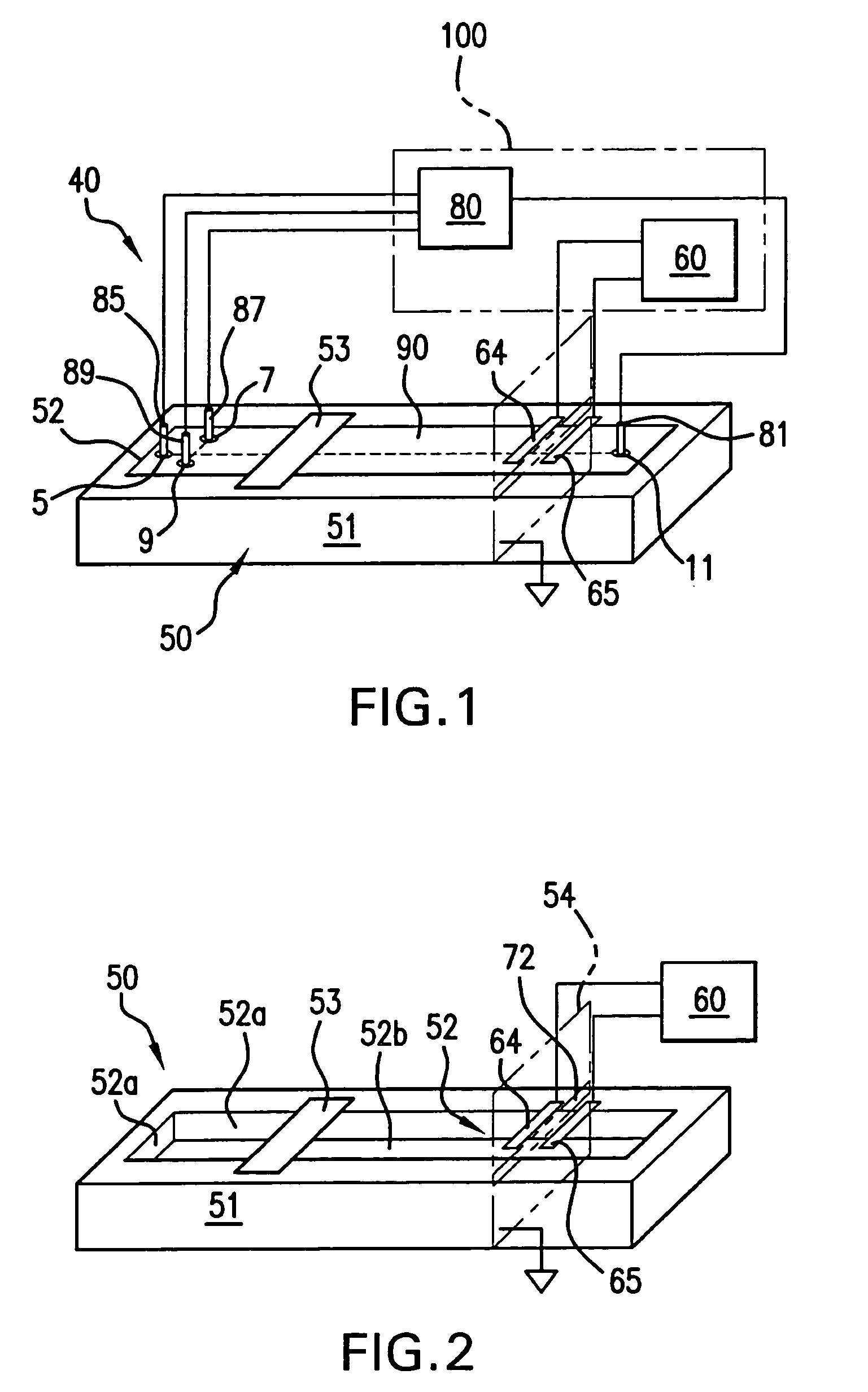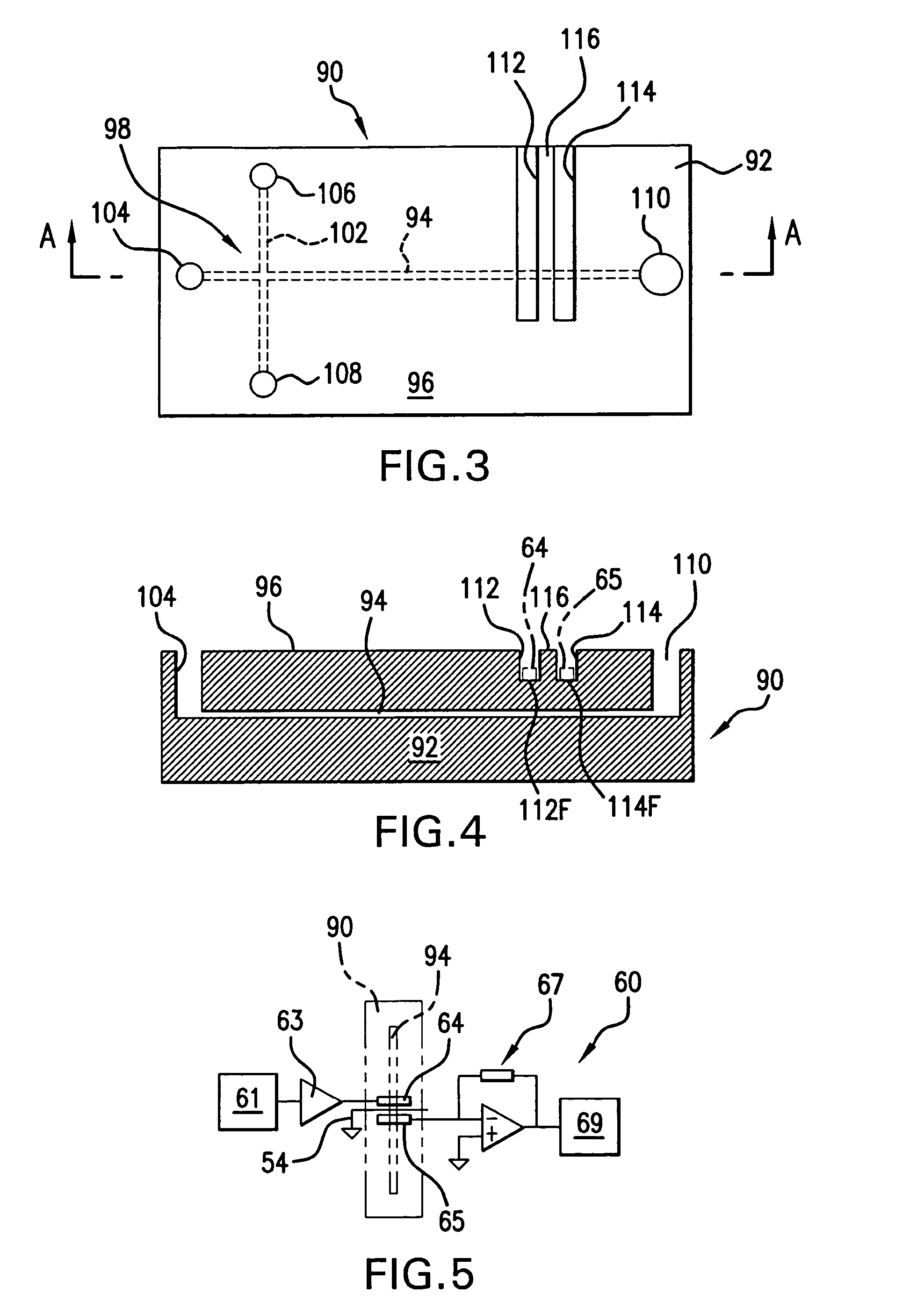Method and apparatus for performing high-voltage contactless conductivity (HV-CCD) electrophoresis
a contactless conductivity and electrophoresis technology, applied in the field of high-voltage contactless conductivity (hv-ccd) electrophoresis, can solve the problems of limited amperometric detection, standard uv absorption techniques are generally not applied to capillary electrophoresis on chips, and limited technology, so as to reduce the adherence of the immunoglobulin complex and the effect of reducing the adherence of each immunoglobulin
- Summary
- Abstract
- Description
- Claims
- Application Information
AI Technical Summary
Benefits of technology
Problems solved by technology
Method used
Image
Examples
first example
The Affect of Grooves on the CE Microchip
[0077] The first example highlights the affect of having the detection electrodes mounted in grooves on the surface of the microchip 90. The microchips used in this first example are commercially available glass microchips (model MC-BF4-TT100, Micralyne, Edmonton, Canada) containing a standard injection cross. The separation channel is 85 μm long with a semicircular cross section of 50 μm width and 20 μm depth buried approximately 1 mm below the upper surface of the microchip. Grooves for placement of the detection electrodes were made in the upper surface of the microchips either by ultrasonic abrasion, with an imprinting tool, or manually using a cutting wheel attached to a high frequency spindle. In either case, the floor of each groove was situated approximately 0.2 mm from the separation channel, and the detection electrodes were formed on the floor of each groove using conductive silver paint. Each detection electrode was approximately...
second example
The Effect of Applied Frequency to Detector Response
[0081] The second example highlights the effect of applied voltage and frequency on the peak height of analyte detection voltage amplitude. Glass CE microchips having detection electrodes placed in grooves were used for this experiment. In this run, 200 μM of lithium analyte in 10 mM MES / his buffer with 2 mM 18-Crown-6 at pH 6 was analyzed using an injection potential of +0.5 kV for 3 seconds and a separation potential of +3 kV. Actuation voltage potentials of 250 Vp-p, 300 Vp-p, and 500 Vp-p were studied at 50, 100, 200 and 300 kHz.
[0082] As shown in FIG. 9, the optimal lithium analyte detection voltage (i.e., highest detection sensitivity) was observed for the combination of 500 Vp-p actuation potential at a frequency of 50 kHz. It is noted that a more stable baseline was observed for the combination of 500 Vp-p at a frequency of 100 kHz. Thus, optimum analyte detection is a function of both the peak-to-peak voltage amplitude a...
third example
Effect of the Separation Voltage on Detection Peaks
[0083] The third example highlights the effect of varying the separation voltage on the analyte detection voltage peaks. Glass CE microchips having detection electrodes placed in grooves were used for this experiment. In this run, potassium, sodium and magnesium at 20 μM in 10 mM MES / his buffer were analyzed using an injection potential of +0.5 kV for 3 seconds and an actuation voltage of 500 Vp-p at 100 kHz. Separation voltages were increased incrementally from (a)+2 kV, (b)+3 kV, and then to (c)+4 kV.
[0084] At +2 kV, the potassium peak had a migration time of 28 seconds, and all peaks were severely broadened. Increasing the separation voltage lead to shorter migration times, sharper peaks, and better detection limits. Using the +4 kV separation potential and repeating the experiment produced detection limits of 0.49, 0.41, and 0.35 μM for potassium, sodium and magnesium respectively. These observed detection limits for potassium...
PUM
| Property | Measurement | Unit |
|---|---|---|
| Length | aaaaa | aaaaa |
| Electric potential / voltage | aaaaa | aaaaa |
| Electric potential / voltage | aaaaa | aaaaa |
Abstract
Description
Claims
Application Information
 Login to View More
Login to View More - R&D
- Intellectual Property
- Life Sciences
- Materials
- Tech Scout
- Unparalleled Data Quality
- Higher Quality Content
- 60% Fewer Hallucinations
Browse by: Latest US Patents, China's latest patents, Technical Efficacy Thesaurus, Application Domain, Technology Topic, Popular Technical Reports.
© 2025 PatSnap. All rights reserved.Legal|Privacy policy|Modern Slavery Act Transparency Statement|Sitemap|About US| Contact US: help@patsnap.com



